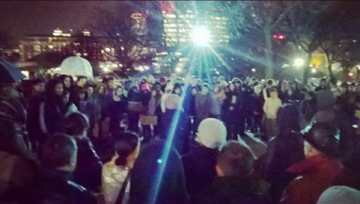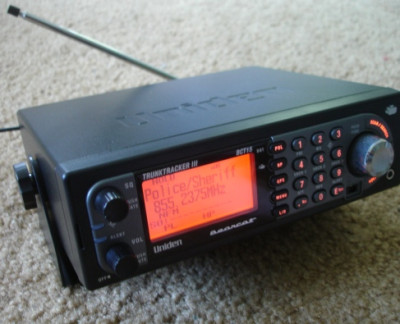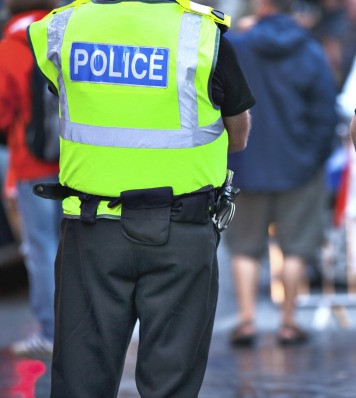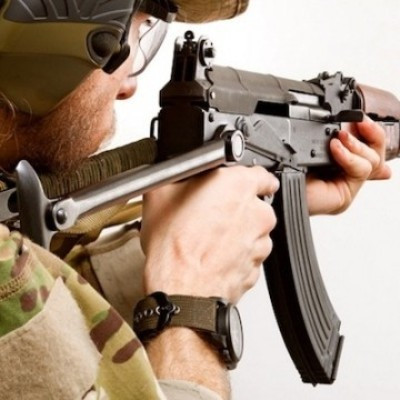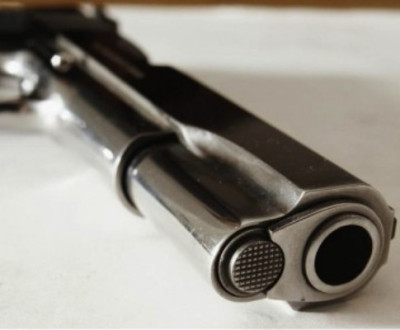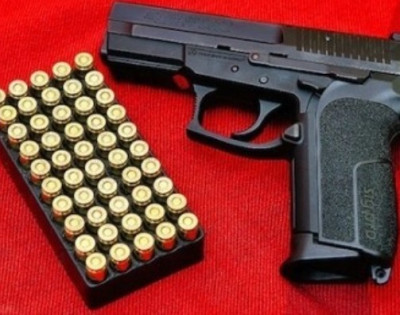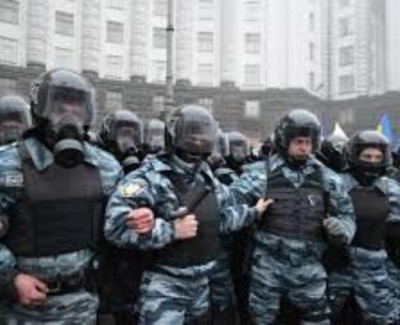RI Battles Over Police Body Cameras
Wednesday, December 03, 2014
Providence leaders and community members are divided over the potential use of police body cameras, following President Barack Obama's proposal Monday of a three-year, $263 million investment package that would increase their use by local law enforcement agencies (LEAs) -- just of over a week following the Ferguson decision, which has resulted in protests around the country, and in Rhode Island.
While the White House outlined that a "new Body Worn Camera Partnership Program would provide a 50 percent match to States/localities who purchase body worn cameras and requisite storage..the proposed $75 million investment over three years could help purchase 50,000 body worn cameras," Rhode Island law enforcement and community leaders are split on the prospect of having them considered for utilization in the state.
"I think it's a tool in which we should have in policing," said Providence Public Safety Commissioner Steven Pare. "I've long advocated for in-car video, and now with the technology and the affordability of the technology, I think it's a good tool to have audio and visual recordings of interactions of police officers and the public."
GET THE LATEST BREAKING NEWS HERE -- SIGN UP FOR GOLOCAL FREE DAILY EBLAST"There are some challenges -- if there's a fear of "Big Brother," there can be a chilling effect on the job you do but the evidence has shown that those departments that have used those devices, and have had the proper training, that it helps defend police officers to dispute allegations of misconduct, and it saves more officers than hurts," said Pare. "It's embraced in those instances where it shows it helps."
Community leaders in Providence had varied opinions, however, as to the benefits -- or drawbacks -- of having the police pursue adopting body cameras.
"I believe that it's a good step in the right direction," said Jim Vincent with the NAACP Providence Branch. "It helps restore faith in terms of the community's faith in the police, and it helps the officer from false claims, which is also good. The big question though is if there's a [camera] malfunction, or how often that happens."
Kobi Dennis, who founded Night Vision in Providence, said he believed the use of body cameras "will be another non-sustainable fix to a lack of professionalism and training issue."
"Policing the police" is something I'm all for but spending money from already strapped city budgets I'm not," said Dennis. "Once again, these approaches are re-active approaches to long standing problems that could be avoided with pro-active approaches. We started with the police required to have badge numbers, they covered the badge. Now we have cameras on the cruisers, who views these tapes?"
"Body cameras will do just what many other temporary, budget draining LEA gadgets have done to aid in better policing - quiet down the roar," continued Dennis. "We need constant mandatory training from the top cop to the rookie. Mandatory residency requirements along with mandatory monthly volunteer hours in the community they serve. Until we fully understand one another's cultures, not even Robo-Cop will save us!"
Providence Mayor-elect Jorge Elorza did not respond to request for comment Tuesday on the President's proposal, or whether or not he would support body cameras for Providence police in the city's budget.
Support for Cameras -- and Concerns
"Body cameras raise somewhat complicated issues," said Steve Brown with the RI ACLU. "They are potentially useful to address police accountability, but [they] also have the potential for abuse."
"Who has access to the records? How long are they kept? Will there be limits on how the recordings are used? Take for instance the police in the middle of demonstrations in Ferguson," said Brown. "Can they use them to ID protestors engaged in protected First Amendment activity?"
"It's like so much other technology, it cuts both ways," said Brown. "There should be clear guidelines and standards established ahead of time."
Ray Watson, Executive Director of the Mt. Hope Neighborhood Association, said that he would fully support body cameras on police in Providence.
"I would support them here in Providence and RI as a whole. From what I've researched, cameras dramatically reduce incidents of abuse of power on the part of law enforcement officials, and also provide an unbiased perspective on interactions that can also serve to support the officers side of the story if he is ever questioned on his actions," said Watson. "Win win for both sides."
"Poor community police relations leads to more violence, more insurance costs for victims of violence who do not have insurance, more police details, etc," continued Watson. "Further, better police conduct will lead to more willingness on the part of community members to work with police to address issues in their communities. We have to start being willing to invest in preventive strategies on the front end so that we don't have to pay for all of these other things on the back end."
Questioning Tactics -- and Money
On Tuesday, Pare addressed the potential costs of body cameras for the Providence police.
"It's always a budgetary issue," said Pare "It's not the cost of the device, but it's the support of the digital information that has to be stored and managed, you have that component. There are other cities have used them for several year, but it hasn't been wide spread deployed."
"And it's not as easy as putting them on and deploying the device," added Pare. "Of course I'd love to see that here in Providence. These devices are $1000-$1500 -- so say we have up to 500 officers, that's at least $500,000 not to mention the cost to maintain these digital images, and storing them, and having personnel dedicated to responding to the public, the courts wanting the [information]."
While the Obama proposal puts forth parameters for federal funding for LEAs, the question of whether or not Providence could afford them would remain to be seen.
"It's not at all clear that Providence could afford these cameras. Their budget is still running in the red and it doesn't seem like that will end in the foreseeable future. Likewise, the budgets of most cities and towns in Rhode Island are either in the red or are close to it," said Monique Chartier with the taxpayer advocacy group RI Taxpayers. "Accordingly, because the federal government is coming up with only half of the cost of the cameras, local elected officials will have to make some difficult budget choices if they decide to take advantage of this program as raising property taxes to pay for this purchase is simply out of the question."
Mt. Hope's Watson said he "didn't accept the response anymore" that there might not be the money for cameras.
"38 studios takes their ability to use that as an excuse away. We found almost 100 million dollars for that fiasco, I say find some money for this," said Watson. "On a local level, once again it's not a matter of if it's going to cost us. It's how much it costs us and when do we pay it. I say pay less up front and [be] proactive rather than more at the end as a result of being reactive."
Community lawyer Shannah Kurland said that instead of police body cameras, she would prefer to see "genuine alternatives" to policing -- and the videotaping to be done by the community, not the cops.
"It would be wonderful to think that body cams or anything else are a magic solution to police racism and violence. But I'm old enough to remember how the police who ruthlessly beat Rodney King got off, despite video proof of what they did. In the case of body cams we need strict guarantees that officers will have no ability to turn them off when it's convenient, and I don't know if that's technologically feasible given Taser International's close relationship with police departments," said Kurland. "Personally, I feel a lot safer when community members are the ones videotaping, and that can only happen when the police respect people's First Amendment rights."
Related Slideshow: Police Militarization - Department by Department Breakdown
Below are those fifteen local police departments that have obtained military supplies, listed from least to most items acquired. The list does not include acquisition records for certain tactical weapons and supplies for which the Pentagon has refused to release department-specific data. (In those instances only county-level data has been released. That data is not included below.) Records are for recent acquisitions going back to 2009 and were obtained from the Defense Logistics Agency.
Related Articles
- Guest MINDSETTER™ Carolyn Thomas-Davis: As World Waits for Ferguson, What RI Can Do
- The Most Militarized Police Departments in RI
- NEW: Hundreds Turn Out in Providence for Ferguson, Mexico Solidarity March
- RI Groups Urge Police to Support Public’s Right to Record Police Activity
- No Indictment in Ferguson: RI Reacts
- Block Calls on Fung to Explain His Role in Cranston Police Scandals
- NEW: Prov. Police Union to Picket Taveras at Gubernatorial Debate
- Unpaid Providence Police Detail Up 50% to Nearly $2 Million
- Organizations Past Due on Police Detail: See Who Owes the Most
- Providence Police Union Slams Taveras on Unpaid Festival Police Details
- NEW: Taveras Endorsed by Brotherhood of Police Officers, Government Employees
- LISTEN: Unpaid Providence Police Detail Up 50% to Nearly $2 Million
- Police Militarization - Department by Department Breakdown
- How Did Cianci Get the Police Endorsement Over Elorza?
- EXCLUSIVE: New Providence Police Officer Named as Suspect in Larceny
- RI Battles Over Police Body Cameras
- INVESTIGATION: John Hope Settlement House Under Investigation by State Police
- Listen: The Most Militarized Police Departments in RI
- Warwick Police and The Providence Center Team Up for Public Safety
- NEW: RI State Police Seize Over 100 Ballots at FOP
- NEW: RI State Police, Providence Police to Hold Community Forum Monday on Ferguson
- Providence’s John Prince Alleges Police Unlawfully Confiscated Phone During Videotaping
- Russell Moore: Taveras’ Police Department Spin Boomerangs
- Providence Police – A Department in Chaos
- NEW: ACLU Calls for Investigation of Cranston Police Dept. Practices




